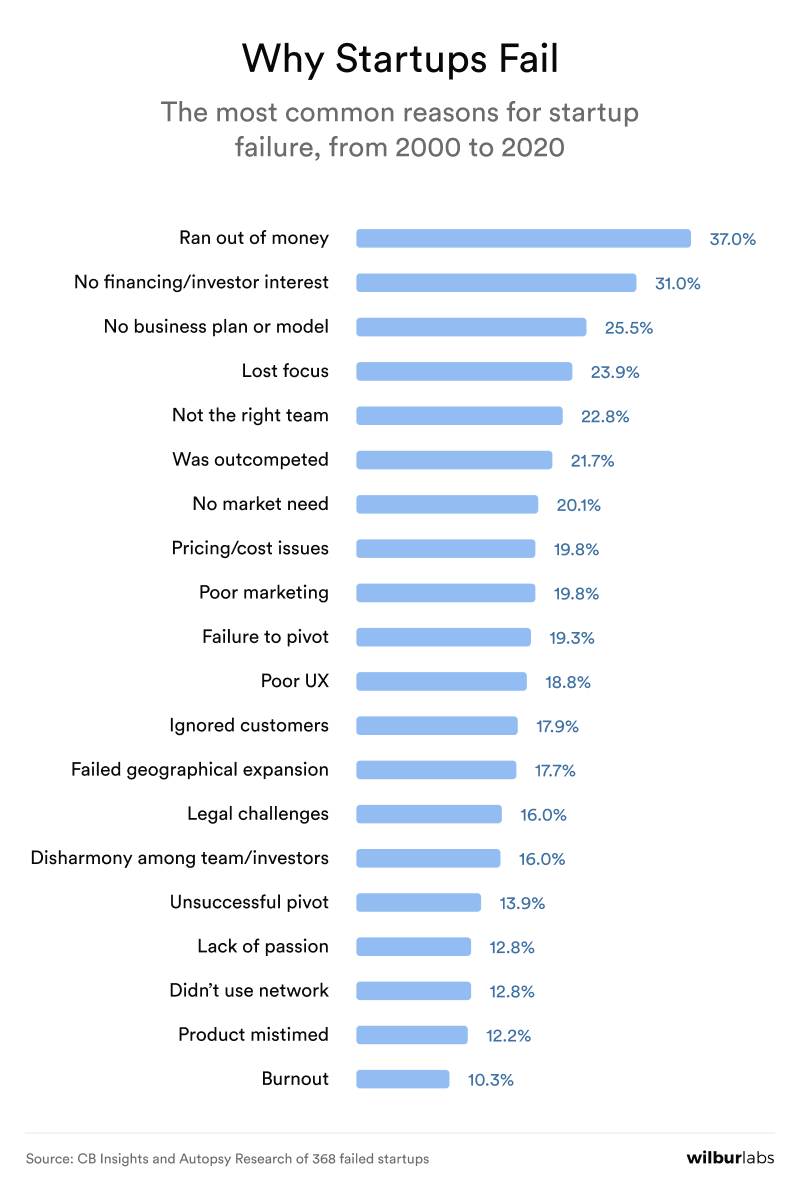I was recently researching the main reasons why startups fail in India – the results surprised me a little. Although my immediate stock response was lack of funds, it was interesting to see the stats pointing towards strategy, business plan and innovation. There are plenty of reasons for startups to fail and as we know the success rate is quite low. But as a founder/entrepreneur, it is necessary for you to be aware of these reasons and create the best chances for your success.
Why do startups fail in india
You may recall this insightful infographic which gives an indication about why startups fail in general. The most common reasons worldwide range from lack of funds to challenges between founders, etc. In this article, I’d like to zero in on the topmost common reasons why startups fail in India.

- Lack of funds, financial support
- Strategy and Focus
- Leadership and Team Building
- Understanding Customer Requirements
- Business Model Failure and inability to adapt to changes
Lack of Funds to build product/grow startup
Although it sounds like a no-brainer, I’d also like to point out how structured/unstructured the investment side is in India. We can see some of the established VC models leading investment in the right direction. However, there are a lot of angel investors who confuse seed funding with debt funding. Finding the right investor is a difficult challenge – particularly in the initial stages of your startup.
The first few stages of investment usually come from personal funds, friends and family, even debt etc. I still feel that the seed funding route makes it a bit difficult for entrepreneurs with good ideas to establish new startups. Most ideas, unfortunately, die in the initial stages.
We can see some help through incubators and accelerators. But I still feel that the investment space expects far more from Indian founders as a proof of concept as opposed to countries where entrepreneurship is more established.
Strategy and Focus
This ties in with the previous reason for the lack of funds. Due to this shortage, startups are rushed to earn money soon to sustain the initial years. It naturally forces the founder to sacrifice strategy or long term vision for short term gains. The moment a founder gives in to this pressure, the long term vision is lost. The strategy might sound a bit theoretical, but it is the lifeblood of your business plan. Every strategic action you take as a founder needs to ask the question -where will this take my business in the next 5 years.
Of course, survival is important, but not at the cost of your business which needs to sustain. As a founder, the best thing you can do is to try and balance these two. If the balance is hard, at least adjust your business plan accordingly so that you know how these decisions impact your long term future of the startup.
I do admit that changing your business plan often is very hard, but at the very least, you can focus on your business model canvas which is a very good 1-page indicator of your overall business strategy. The most important thing to note is a reminder to keep asking strategic questions and not to get lost in the moment.
Leadership and Early Team
One of my earliest and most prominent experiences of fundraising is the importance of a team. Each time I entered the room with investors, the first question was about the team and their competence. The team plays a pivotal role to give confidence to the investor that – this idea is backed by talented people who believe in the vision. The investors know that finding good talent is hard.
If you’re unable to find good talent, make sure you find good mentors for your startup. But be careful that the mentor is not namesake and they’re actively involved. These mentors act as a stamp of approval in some conversations. You can also follow the advisor route, but the best one is still about finding the right team.
Another point I’d like to highlight is that the right team is not cheap. Don’t be stingy with your equity – follow a good financial model and be fair to the people who join at the early stages. At this stage, even your team is making a huge sacrifice by joining you. Their risk must be equally rewarded or else it is very easy to lose good people and very hard to recover from it.
Understanding Customer Requirements
You might argue that this is not a specific reason why startups fail in India. You’re right – as generic as this reason is, understanding customer requirements is quite difficult. It will demand time to be invested to understand the changing needs of your customer.
In addition, you’ll also need to be aware of your bias while gathering customer requirements. The difficulty in a startup stage is that you don’t have a large sample of customers to provide you with valuable feedback. As a founder, you start on a hunch and then try to validate this feeling. There’s nothing wrong with this approach – many other established companies also take the same route.
An important point to note here is that – feedback gathering alone is not the most valuable thing. What you make out of this feedback is more prominent. Make sure that you ask the question – is this a pervasive need or specific to one customer? Can I scale this idea if I follow this feedback? In these questions, you’ll be able to distinguish whether you’re a startup or a small business.
Failure in business model/market fit
I’m taking a conscious note to stop this article for this final reason. We can certainly talk about product-market fit, adapting to customer changes and many other valid reasons. But these all contribute to your business model.
In the end, a great product alone doesn’t guarantee success. The quality of the problem you’re solving, its value to the customers and whether the problem is large enough so that people are willing to pay the right price makes a huge difference. You’ll not have all the answers, but equally, the business model should change along with the market. It won’t be perfect.
The business model must also adapt with the route to market, your pricing strategy and many other equally important strategic decisions. The key is to make sure that you keep going at it from different approaches. Keep coming back to your strategy and revising it.

Pingback: What is a startup- 4 differences with small business - Inspire99
Pingback: Money is like gasoline during a roadtrip! - Inspire99
Pingback: Don’t assume that borrowing lots of money can make your startup fly! - Inspire99
Pingback: Startup India - How useful is it for entrepreneurs? - Inspire99
Pingback: 5 Key Strategic Points - How to build a startup with no money - Inspire99